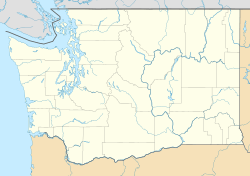Ainsworth, Washington facts for kids
Quick facts for kids
Ainsworth, Washington
|
|
|---|---|

Franklin County, Washington
|
|
| Country | United States |
| State | Washington |
| County | Franklin |
| Platted | 1879 |
| Time zone | UTC-8 (Pacific (PST)) |
| • Summer (DST) | UTC-7 (PDT) |
Ainsworth, Washington, was a town located in Franklin County, Washington. It was built on the north bank of the Snake River, near where it meets the Columbia River. Today, this area is part of Pasco, Washington. Ainsworth is known as a ghost town because it no longer exists.
History of Ainsworth
Ainsworth was created as an important stop, called a "depot," for the Northern Pacific Railroad. The town was named after John C. Ainsworth, who was the president of a large boat company called the Oregon Steam Navigation Company. The layout of the town was officially planned in 1879.
Life in Early Ainsworth
Thomas Symons, an engineer working for the U.S. Army, once described what it was like to live in Ainsworth. He noted that it was a very difficult place to be. There were no trees, and the summers were extremely hot. Strong winds often blew sand everywhere, which made it hard on people's eyes.
When Franklin County was formed in 1883 from Whitman County, Ainsworth became its first county seat (the main town where the government offices were located). At that time, many Chinese workers also lived in Ainsworth. They often worked for the railroad and ran local businesses.
The Town Moves to Pasco
In 1884, a railroad bridge was finished across the Snake River. This bridge made it easier to travel and transport goods. By 1885, many of the buildings in Ainsworth were taken apart or moved to the nearby town of Pasco.
The Chinese workers also moved to Pasco and created their own neighborhood there. However, most of them left the area once the railroad construction was completed and there was less work. In 1885, the State Legislature officially moved the county seat from Ainsworth to Pasco.
Over the years, Pasco grew larger and eventually covered the original site where Ainsworth once stood.



